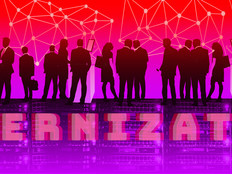While SDx is led by software-defined networking, the other solutions within the “software-defined” umbrella are equally compelling to many state agencies. With software-defined data centers, for example, virtualization allows for better scalability as an organization grows, and it helps agencies realize cost savings through reductions in onsite energy consumption.
And then there’s software-defined storage, where the typical distributed hardware system is replaced with a virtual storage solution. IBM, which offers a SDS solution the company calls Spectrum Storage, has described the technology as placing “a layer of software between storage and applications in order to help manage data growth and enable multicloud flexibility.”
MORE FROM STATETECH: Find out the key differences between SD-WAN and MPLS.
The Benefits of Software Defined-Everything
Another major player in the software-defined market, Hewlett Packard Enterprise, has noted that the benefits of a software-defined infrastructure revolve around integration and automation. Among the major advantages of software-defined infrastructure, according to HPE:
- Simplified, standardized IT consumption models: Full data center virtualization enables agencies to flexibly configure compute, networking and storage resources on a per-application basis from commoditized hardware.
- Automated configuration, backups and data recovery: The public sector can use application-aware infrastructure to automatically handle app requirements, security and disaster preparedness functions.
- Ease of management: Dashboards that are similar to application storefronts let users easily provision and monitor software-defined infrastructure.
- Fully integrated hybrid cloud capabilities: Software-defined infrastructure lets agency IT staff put workloads in private or public clouds “as appropriate to maintain data integrity while increasing speed and efficiency and decreasing costs.”
Given the potential for software-defined everything to redefine IT infrastructure, it’s perhaps not surprising that the biggest players in digital technology are jostling for position in the SDx market.
“We’ve software-defined our entire portfolio,” says Marc Moffett, Cisco’s senior systems engineering director for the U.S.public sector. “The bottom line is, this is where the industry is headed, and it’s where we’re heading as well.”
MORE FROM STATETECH: These are the key state and local government IT trends to stay on top of in 2020.
How State Agencies Can Use Software-Defined Networking
Many of Cisco’s state government agency customers, Moffett notes, “are still in discovery mode” when it comes to software-defined infrastructure. Some have adopted the company’s software-defined WAN solution to securely connect the networks of dispersed branch offices through the cloud, and a growing number are turning to the company’s other software-defined products, like Cisco Software-Defined Access and Cisco UCS. (SD-Access, Moffett explains, is an intent-based networking solution that automates user access policy across a network, while Cisco Hyperflex and SD-Storage are the company’s SD-storage solutions.)
“The No. 1 benefit with software-defined is decreased complexity and cost,” Moffett says. Most state governments, he points out, choose to house their main offices on a central campus, but then they also maintain countless remote branches scattered over hundreds of square miles.
The rollout of traditional routing infrastructure at that scale involves a “box-by-box configuration,” he says, with each box containing both the control plane and the data plane. But replace that infrastructure with a software-defined solution, and “deployment is simple because you’re decoupling those two functionalities.”
That same decoupling, Moffett says, allows software-defined solutions to add programmability to IT infrastructure by separating the management aspect from the underlying hardware. And that opens up opportunities for automation, where tasks that once would drain IT’s time are now handled in seconds on a computer screen. “Virtualization is what has made all of this possible,” Moffett notes. “Now we can let the software do this work and get humans back to doing what humans do best.”
The fact that software-defined networking and other SDx solutions might free up his team to focus on other work is not lost on Bonestell at Durham County. In addition to the implementation of Cisco ACI, the county recently installed Cisco DNA Center, the foundational controller and analytics platform at the heart of SD-Access.
“Getting into the software-defined access realm is definitely part of the plan,” he says. The technology will permit monitoring of the county’s network at a level his short-staffed team couldn’t reach before. “We’ll get that extra layer of security for all of our users’ devices and applications, but it’s not going to take up any more of our time.”
Over the coming years, Bonestell predicts, Durham County will continue to adopt SDx solutions that promise to improve efficiency across IT. “The way I look at some of these software-defined pieces, we’re buying software in place of another full-time employee. It’s an investment that not only helps the team that I have to do the jobs we’re supposed to do, it also saves us money.”












